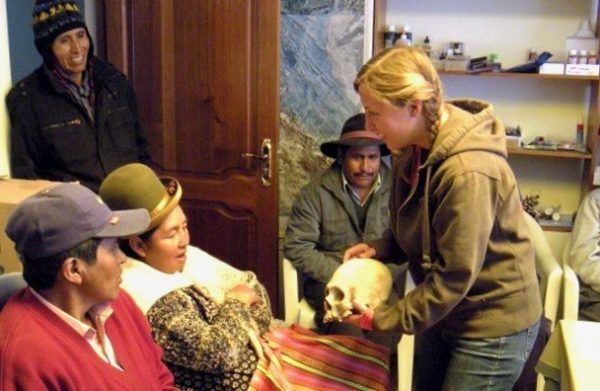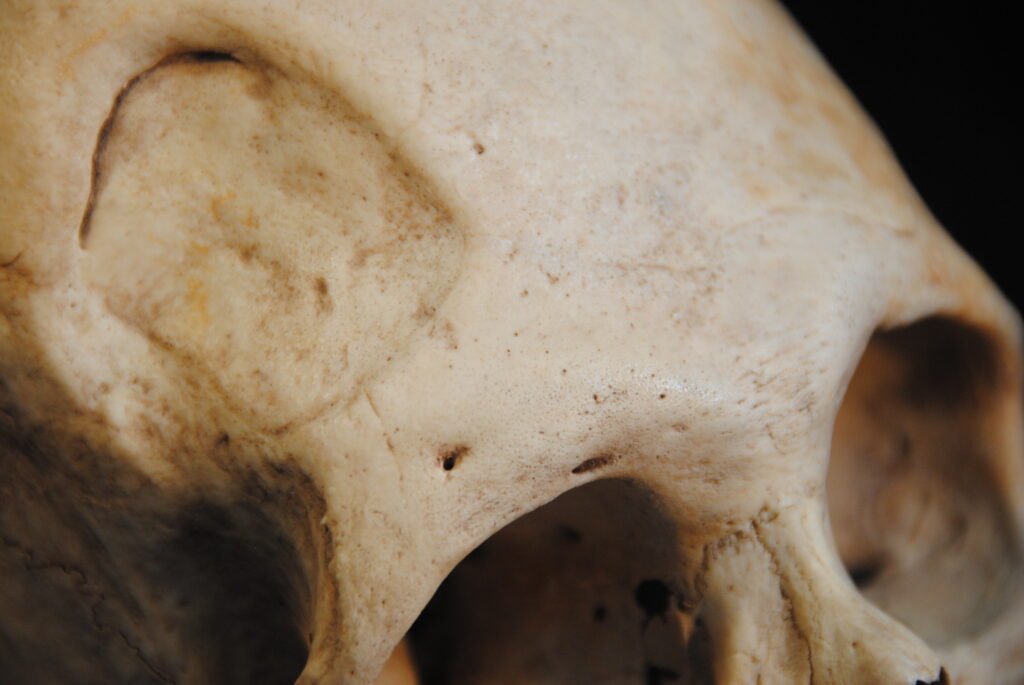Bioarchaeologist Studies Bones to Illuminate Past Lives

Individual 6 was about 30 to 40 years old when he died. His bones, dating to between AD 1000-1450, were found alongside the remains of eight other people in the Copacabana Peninsula in Bolivia’s Titicaca Basin, near Peru.
While each of the nine skeletons exhibited trauma, the evidence inscribed on his remains showed that Individual 6 had suffered significantly. He had sustained a massive cranial fracture – a deep depression in his forehead that cracked his skull all the way around. Judging by the severity of his injury, it is likely that he was unconscious for a period of time and certainly recovering for weeks.
Yet, while his bones spoke of massive injury, they also clearly told a story of survival. Somehow, the grievous injuries healed. When bones break, like Individual 6’s did, the edges along the fracture are often sharp and cracked. Over time, if the body heals, new bone builds up and slowly smooths over the jagged edges. By studying how a bone was broken, the location of the fracture, and the signs of healing, scholars can learn about the injury – and gain some clues about what followed in the person’s life.

One such scholar, UNC Charlotte bioarchaeologist Sara L. Juengst, was drawn to the details of Individual 6’s life that were revealed by the healing of his bones. His injuries had mostly mended by the time he died, meaning that he must have lived for years after the initial wound. She could envision that he even received some care as he healed. She thinks about what that may imply about the society around him.
“I like to think about the fact that even in times in the past where there was a lot of widespread violence, people were still taking care of each other,” she says. “And I think that is the story we tell less often. We talk about whether violence is innate and are humans naturally violent, but we don’t really debate whether humans are naturally caretakers. Do we naturally take care of somebody who’s hurt? Is that an instinct as well? Some of my research has looked at these people who were really beaten up, but they had healed injuries. In some cases they actually had surgeries to help them survive.”
Bioarchaeologists like Juengst are part archaeologist, part biological anthropologist. They study human skeletal remains to learn about and tell the stories of past communities and cultures. While archaeologists more often study settlement patterns and artifacts like ceramics or stone tools from historical excavations, bioarchaeologists study burial sites, items found at burial sites, and bones.
“It is a way to understand what people lived through, and what their lives were like in a very direct way.”
Sara L. Juengst
By studying a person’s bones, Juengst can determine details about the person, such as age and sex, as well as a person’s diet and overall health. Bioarchaeologists can tell if a person was chronically ill or nutritionally deprived as a child by looking at teeth or measuring the length of bones. That is because a person’s body would divert resources toward keeping them alive as opposed to building teeth or growing taller.
“If you think back to your high school anatomy course or whenever you learned about human body systems, people think about the skeleton as this kind of static framework for muscles and organs,” she says. “But your skeleton is actually responding to everything you do over the course of your life or everything that happens to you.”
Bioarchaeologists can also sometimes discern biodistance, which is how groups are separated by time or geography, by studying the structural variation in bones and teeth.
An assistant professor in the Department of Anthropology, Juengst spends time at excavations in South America, specifically the Andes Mountain region of Bolivia. She has also worked in Peru and has started a new excavation project in Ecuador. Her research has focused on violence levels and medical practices in past Andean populations, diet and the body, and cultural and societal implications.
“I’m interested in questions of social identity and community and not just what people did but also how they conceived of themselves and their worlds and what that meant for power relationships and their daily lives.”
Sara Juengst
In 2017, she co-edited a book, “The Bioarchaeology of Community,” published by the American Anthropological Association. She and co-editor Sara K. Becker shaped the book to address the question of what human skeletal remains can tell us about collective identity. Most of the prior literature on collective social identity has focused on the family or state-level society, but people really live their lives at an in-between, mid-level form of community, Juengst says.
After organizing a symposium on the topic, Juengst and Becker worked with authors and symposium presenters to pull together this volume of theoretical discussions and case studies from diverse time periods – 3000 B.C.E through the modern era – and varied geographic areas, including North, Central and South America and Western and Eastern Europe. The articles consider the concept of community by conceiving human skeletal remains as more than physical bodies. Instead, skeletal remains reflect the lived experiences of people. The research delved into whether a bioarchaeological lens could find evidence of community.
In addition to co-editing the volume, Juengst authored a study in the book investigating how communities in the Titicaca Lake Basin of Bolivia were structured during the Early Horizon Period of 800 B.C.E. to C.E. 200. During this time, communities in the lake basin area underwent significant social and economic changes. People lived in sedentary settlements for the first time. They domesticated plants and animals and established long-distance trade, while also creating the first regional ritual tradition.
She considered whether these changes affected how individuals related to one another.
“Archaeology is often unable to explore relationships that are not materially manifest; bioarchaeology can do so by studying bodies directly,” she says in the article. “Bioarchaeology explores who people were and who they associated with through their skeletons, as social transformations and interactions are inscribed on people’s bodies through what they ate, where and how they lived and how they were related to each other.”
With her work on the book, her research papers, and the approach she takes in her classes and on study abroad trips with students, Juengst reminds us to take great care. People’s remains, and the items they leave behind after their deaths, are more than simply objects. They reveal the intimate stories of their lives and deaths, and they deserve respect, she says.
“By focusing on community, you think about these bones as living individuals who you know had dreams and cared about people and had social networks,” she says. “So, I think that focus is an important reminder for bioarchaeologists and, broadly speaking, all people who study the past.”
Words: Caitlin Mauk | Images courtesy of Sara Juengst and shared with permission of descendant communities. | Top Image: Sara Juengst shares her insights from studying skeletal remains with local residents in Bolivia.